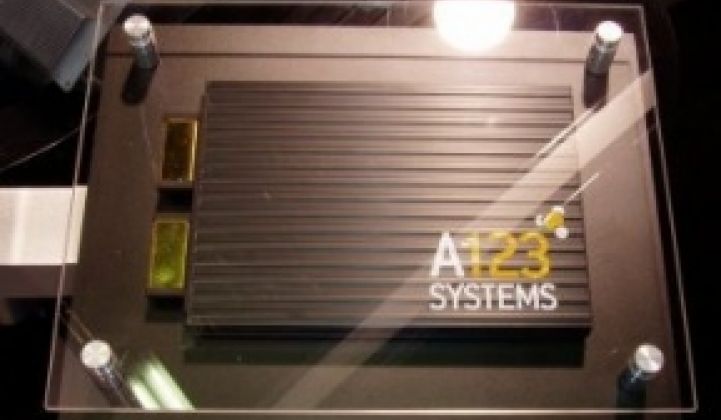It's the sprawling American saga that storms across 132 pages and seven attachments.
No, it's not a newly unearthed draft of James Michener's Hawaii. It's the S-1 document filed by A123 Systems with the Security and Exchange Commission.
The company – which grew out of research conducted by Yet-Ming Chiang at MIT – is at the forefront in the effort to build a battery industry in the U.S. It sells batteries to Chrysler and BAE Systems. And recently it landed a $249 million grant from the Department of Energy to build a factory in the U.S. – not bad considering most of the company's factory capacity is now in China and South Korea. GTM Research analyst Eric Wesoff speculates that the company could open the floodgates for more.
But the company also lost out to supply batteries to the Chevy Volt and it has yet to turn a profit. Here are the highlights:
- $168.5 million – The total in revenue accrued since early 2006 when it started selling batteries. It breaks down as: $34.3 million (2006); $41.3 million (2007); $68.5 million (2008); $10.3 million (Q1 2008); and $23.2 million (Q1 2009).
- $146 million – Cumulative net losses. Net losses by the year have been: $15.8 million (2006); $31 million (2007); $80.5 million (2008); and $18.7 million (Q1 2009).
- $106.3 million – The total capitalization.
- 75 percent – The amount of revenue that comes from the top three customers. "We believe that the loss of one of these significant customers [BAE Systems] could have a material adverse effect on our revenue," the S-1 states. BAE Systems, which is working with A123 on bus systems, is an interesting touch. In an earlier S-1, it said that Black &Decker "represented 70.7% of our total revenue since inception through March 31, 2008 and represented 55.1% of our total revenue in the quarter ended March 31, 2008." Revenue dipped at the time due to a slowdown from its "most significant" customer.
- 107.5 million – The number of watt-hours, or electrical capacity, contained in the batteries shipped to date. It breaks down as: 20 million (2006); 32 million (2007); 44.9 million (2008); 10.6 million (Q1 2009).
- 151.1 million – The total annual manufacturing capacity, measured in watt hours, as of March 2009.
- 450,000 square feet – The amount of factory space.
- $96.6 million– The cumulative amount invested in R&D.
- Dec. 4, 2001 – The date MIT gave an exclusive license to A123 to commercialize the technology.
- 16 – The number of owned or exclusively licensed U.S. patents as of March 31, 2009. It also has 55 pending patent applications in the U.S., 23 granted foreign patents and 139 foreign pending patents.
- 1,819 – The number of full-time employees as of June 1, 2009. "As of June 1, 2009, we had 1,819 full-time employees, with 227 in research and development, 1,440 in manufacturing. Of our employees, 317 are located in the United States and 1,502 are abroad." the S-1 states. "We consider our current relationship with our employees to be good." A123 also has 31 employees in sales and 121 in administration.
- Low for now – "None of our employees are represented by labor unions or have collective bargaining agreements, except for certain employees in our Changzhou, China facilities who established a Labor Union Commission in 2007," the S-1 states. A123, however, hopes to use its $249 million grant to build factories in Michigan.
- 19 – The number of hybrid and electric vehicles models in 2009 with a production run of 20,000 or more.
- 200 – The anticipated number in 2019.
- 16 megawatts – The capacity in battery packs sent to utility AES in a load balancing experiment currently being conducted.
- 3 – The number of acquisitions: $14.3 million for South Korea's Enerland; $100,000 for hybrid retrofitter Hymotion; and $6.8 million for T/J Technologies.
- 10 – The number of hybrid conversions that A123 would have to cover the cost of Hymotion. The conversions cost about $10,000.



